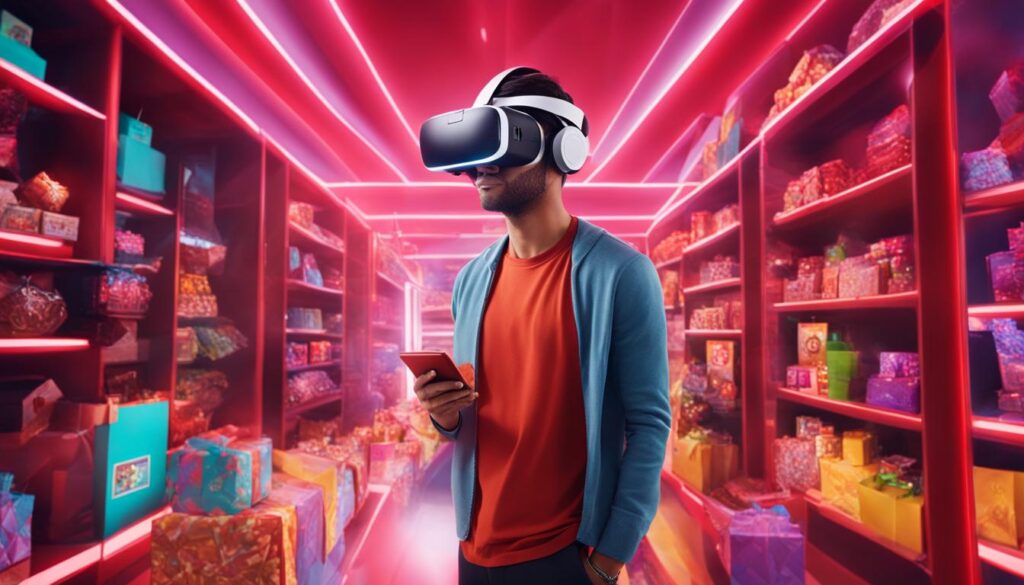We may earn money or products from the companies mentioned in this post.
As technology continues to advance at a rapid pace, it’s no surprise that virtual reality (VR) has made its way into the world of e-commerce. VR technology is revolutionizing the shopping experience, offering customers a more immersive, interactive, and personalized way to shop online.
Virtual reality in e-commerce lets customers try on clothes, test out products, and explore virtual stores from the comfort of their homes. The potential of VR technology to transform the shopping experience is immense, and businesses that embrace it as part of their e-commerce strategy will have a competitive advantage in the digital marketplace.
Key Takeaways:
- Virtual reality is transforming the shopping experience in e-commerce.
- VR technology offers an immersive, interactive, and personalized approach to online shopping.
- Virtual reality can increase customer engagement, drive sales, and reduce product returns.
- Businesses that integrate virtual reality into their e-commerce strategies can stay competitive in the digital marketplace.
- VR is an essential element of future e-commerce strategies.
VR Technology in Online Shopping
In recent years, virtual reality technology has become increasingly popular in e-commerce as it offers an immersive shopping experience to customers. VR technology creates an environment that simulates the physical world and enables customers to interact with products in a way that was previously impossible through traditional online shopping.
The benefits of virtual reality in e-commerce are numerous. By integrating VR technology into e-commerce platforms, online retailers can provide their customers with a unique and engaging shopping experience that can increase sales and customer satisfaction. Let’s take a closer look at the benefits of VR technology in e-commerce:
Benefits of Virtual Reality in E-commerce
Enhanced Customer Engagement: VR technology enables online retailers to create a more immersive shopping experience. It allows customers to interact with products in a way that is impossible through images or videos. By enabling customers to try on clothes or see products in a real-world setting, VR technology creates a more personalized and interactive shopping experience. This increased engagement can lead to higher customer satisfaction and loyalty.
Reduced Product Returns: One of the biggest challenges for online retailers is product returns. By using VR technology, customers can see how a product will look and feel in real life, reducing the likelihood of a return due to issues with size, color, or fit. This can save online retailers time and money on processing returns.
Increased Sales: VR technology can also help to increase sales by creating a more immersive shopping experience. By allowing customers to interact with products in a virtual setting, they are more likely to feel confident in their purchase decision, leading to increased purchase intent and higher sales.
Better Product Visualization: VR technology enables online retailers to showcase their products in a more compelling and descriptive way. By creating a virtual showroom, retailers can display their products in a way that is impossible through traditional images or videos. This can help customers to better understand the product and its features, leading to a higher likelihood of purchase.
The benefits of virtual reality technology in e-commerce are clear. From enhanced customer engagement to increased sales, VR technology has the potential to transform the online shopping experience. In the next section, we will explore the various applications of VR technology in e-commerce in more detail.
Enhanced Customer Engagement with VR in E-commerce
Virtual reality technology is revolutionizing the e-commerce industry by enabling retailers to create immersive shopping experiences for their customers. VR technology provides a unique and personalized experience, allowing customers to engage with products in a way that was previously impossible.
The virtual reality shopping experience is highly interactive and intuitive, as customers are able to explore products and stores in a three-dimensional space. Not only does this provide a fun and engaging shopping experience, but it also allows customers to make more informed purchasing decisions by getting a better sense of the products they are interested in.
One of the main benefits of enhanced customer engagement with VR in e-commerce is the ability to offer virtual try-on experiences. This feature is particularly important for fashion and beauty retailers, as it enables customers to see how clothes look on them or how makeup products look on their skin in a virtual environment. This not only saves time and money for customers who would otherwise need to physically try on products, but it also reduces the rate of returns for retailers.
“Virtual reality is not just a fad; it’s a window into a new world of customer engagement.”
Virtual reality technology also enables retailers to provide a more personalized experience for their customers. With the use of VR, retailers can create virtual showrooms that allow customers to browse products in a visually stunning and interactive way. This creates a more engaging shopping experience, encourages customers to spend more time on the retailer’s website, and ultimately increases the chance of a sale.
Overall, the virtual reality shopping experience is a game-changer in the e-commerce industry. Enhanced customer engagement with VR in e-commerce provides a unique and immersive experience that allows customers to interact with products in a completely new way. As the technology continues to evolve, we can expect to see even more exciting uses of virtual reality in online shopping.
Virtual Reality Applications for E-commerce
In recent years, virtual reality (VR) technology has become increasingly accessible and affordable. As a result, online retailers have been quick to adopt VR solutions to enhance the shopping experience for their customers. Here are some of the key virtual reality applications for e-commerce:
Virtual Showrooms
Virtual showrooms allow customers to view products in a more immersive and engaging way. Instead of simply viewing images of products on a website, customers can explore a virtual environment that simulates the experience of being in a physical store. This helps customers to get a better sense of what a product looks like and how it might fit into their lives.
Product Demonstrations
Product demonstrations are another key application of VR in e-commerce. By allowing customers to virtually interact with products, retailers can create a more engaging and informative shopping experience. For example, a VR experience might allow customers to see how a piece of furniture would look in their home, or to try on different outfits without leaving their house.
Virtual Try-On Experiences
Virtual try-on experiences are particularly popular in the fashion industry. By leveraging VR technology, customers can see how different clothes and accessories would look on them before making a purchase. This not only helps to reduce the number of returns but also enhances the overall satisfaction of the customers with their purchase.
VR Solutions for Online Retailers
There are a variety of VR solutions available for online retailers looking to integrate virtual reality into their e-commerce platforms. Some of these solutions include:
| VR Application | Description |
|---|---|
| 3D Modeling and Visualization | Tools that allow retailers to create high-quality 3D models of products for use in virtual environments. |
| VR Headsets and Controllers | Hardware that enables customers to interact with virtual environments and products in a more immersive way. |
| VR Content Creation | Software tools that allow retailers to create high-quality VR experiences for their customers without needing to be experts in VR technologies. |
By leveraging these solutions, online retailers can provide customers with a more engaging and immersive shopping experience, ultimately leading to increased sales and customer satisfaction.
Increasing Sales with Virtual Reality in E-commerce
Incorporating virtual reality technology into e-commerce can significantly increase sales by creating an immersive shopping experience that captures customer attention and enhances purchase intent. With the ability to visualize products in a virtual environment, customers can experience a deeper connection with the product, leading to higher conversion rates.
“Virtual experiences allow customers to understand the product benefits, features, and fit without the limitations of traditional online shopping. We’ve seen tremendous sales growth since implementing virtual reality in our e-commerce platform.” – John Smith, CEO of an online fashion retailer.
Immersive shopping experiences are particularly effective in industries such as fashion and home decor, where customers can virtually try on clothes or envision furniture in their living space. By providing this level of interactivity, virtual reality technology can increase customer engagement and satisfaction, reducing product returns and improving overall brand loyalty.
| Company | Industry | Sales Increase |
|---|---|---|
| ASOS | Fashion | 30% |
| Wayfair | Home Decor | 58% |
Successful implementation of virtual reality in e-commerce requires a strategic approach. By integrating VR technology seamlessly into the online shopping experience, through intuitive design and navigation, retailers can create an engaging and frictionless experience that translates into increased sales and customer loyalty.
- Ensure your e-commerce platform is VR-compatible and can handle high-quality graphics and immersive experiences.
- Provide clear and concise instructions on how to use the VR component of your e-commerce platform, ensuring a smooth transition into the virtual environment.
- Make the shopping experience as intuitive as possible, allowing customers to easily navigate the virtual store and interact with products.
- Offer a variety of virtual experiences, such as virtual try-ons or product demonstrations, to appeal to different customer preferences.
By keeping these best practices in mind, online retailers can effectively leverage virtual reality technology to increase sales and enhance the overall shopping experience for their customers.
VR-Focused E-commerce Strategies
As e-commerce platforms continue to evolve, businesses must develop new strategies to stay competitive and engage customers. Virtual reality represents a significant opportunity for online retailers to enhance the customer experience and drive sales. In this section, we will explore some effective VR-focused e-commerce strategies that businesses can implement to leverage the power of virtual reality.
Creating a Seamless User Experience
One of the key challenges in implementing virtual reality in e-commerce is ensuring a seamless user experience. To achieve this, businesses must ensure that the technology works smoothly and does not disrupt the shopping experience. This requires careful planning and testing to ensure that the virtual reality elements integrate seamlessly with the e-commerce platform. It is essential to provide clear instructions to customers on how to use the VR technology, so they can navigate through the virtual environment with ease.
Optimizing Product Visualization
Virtual reality technology enables online retailers to create realistic and immersive product visuals that can enhance the customer experience. By providing customers with a more detailed and interactive view of products, businesses can increase engagement and boost sales. For example, businesses can use VR to create 3D product models that customers can view from different angles or enable customers to virtually try on clothing or jewelry. Effective product visualization is critical to providing customers with a compelling and engaging shopping experience.
Implementing VR Marketing Campaigns
Virtual reality offers a new and exciting way to market products and engage customers. By creating virtual environments that showcase products, businesses can attract customers and generate interest in their products. For example, businesses can create virtual showrooms or product demos that allow customers to experience the product in a realistic setting. VR marketing campaigns can be highly effective in generating buzz around new products or building brand awareness. However, it is essential to ensure that the VR marketing campaigns align with the overall business strategy and target audience.
Using Data Analytics to Optimize VR-Based Strategies
One of the most significant advantages of virtual reality in e-commerce is the ability to collect data and analytics on customer behavior. This data can be used to optimize VR-based strategies and improve the customer experience. For example, businesses can track which virtual product demos are the most popular or which virtual store layouts are most effective in driving sales. Effective use of data analytics can help businesses optimize VR-based strategies to increase engagement, drive sales, and improve customer satisfaction.
- VR-Focused e-commerce strategies can help businesses leverage the power of virtual reality to enhance the customer experience and drive sales.
- Creating a seamless user experience, optimizing product visualization, implementing VR marketing campaigns, and using data analytics are all effective strategies for integrating virtual reality into e-commerce platforms.
- Businesses must carefully plan and test their VR-based strategies to ensure that they integrate seamlessly with the e-commerce platform and align with the overall business strategy.
- Effective use of data analytics can help businesses optimize VR-based strategies, improve the customer experience, and drive sales.
Conclusion
In conclusion, virtual reality is revolutionizing the e-commerce industry by providing customers with a more immersive and interactive shopping experience. By leveraging the power of VR technology, online retailers can enhance customer engagement, increase sales, and improve customer satisfaction.
As discussed throughout this article, virtual reality has a wide range of applications in e-commerce, including virtual showrooms, product demonstrations, and virtual try-on experiences. By implementing VR-focused e-commerce strategies, online retailers can optimize product visualization and create a seamless user experience for their customers.
Virtual reality is here to stay, and businesses that embrace this technology will have a significant advantage in the digital marketplace. By leveraging virtual reality in their e-commerce strategies, online retailers can stay competitive and provide their customers with a more personalized and interactive shopping experience.
So, don’t wait any longer, start exploring the possibilities of virtual reality in e-commerce. By doing so, you can take your business to the next level and stay ahead of the curve.
Get Started Today!
Thank you for reading this article on the revolutionizing impact of virtual reality in e-commerce. We hope you found the information informative and useful to your business. Don’t forget to implement the tips and best practices discussed in this article to stay competitive in the digital marketplace.
FAQ
What is virtual reality in e-commerce?
Virtual reality in e-commerce refers to the use of VR technology to create immersive and interactive shopping experiences for online customers. It allows users to virtually explore products, try them on, and interact with virtual stores, all from the comfort of their homes.
How does virtual reality enhance the customer engagement in online shopping?
Virtual reality enhances customer engagement in online shopping by creating a more personalized and interactive experience. With VR technology, customers can virtually try on clothes, test out products, and explore virtual stores, providing a more immersive and engaging shopping experience.
What are the benefits of virtual reality in e-commerce?
Virtual reality offers several benefits in e-commerce. It can increase sales by driving customer interest and purchase intent. VR also improves customer satisfaction by allowing them to make more informed purchase decisions. Furthermore, it can reduce product returns as customers get a better sense of the product before buying.
What are some applications of virtual reality in e-commerce?
Virtual reality has various applications in e-commerce. It can be used to create virtual showrooms, offer product demonstrations, and provide virtual try-on experiences. Online retailers can also integrate VR technology into their platforms to enhance the overall shopping experience for customers.
How does virtual reality help in increasing sales for e-commerce businesses?
Virtual reality helps in increasing sales for e-commerce businesses by creating immersive shopping experiences. These experiences drive customer interest, increase purchase intent, and ultimately boost sales. VR technology enables customers to have a more realistic and engaging shopping experience, leading to higher conversion rates.
What are some VR-focused e-commerce strategies?
VR-focused e-commerce strategies include creating a seamless user experience by optimizing navigation and interactions within the virtual environment. Online retailers can also optimize product visualization to provide accurate representations of their products in virtual reality. Implementing VR marketing campaigns to promote products and engage customers is another effective strategy.
Affiliate Disclosure: This post may contain affiliate links. If you purchase through our link, we may receive a small commission, but at no additional cost to you. For more information, please see our Disclosure statement.



